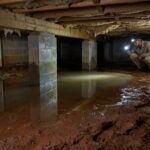Essential Guide to Effective Foundation Repair: Techniques and Tips for Homeowners
When you think about the elements that make up your home, the foundation might not be the first thing on your mind. You probably spend more time pondering the aesthetics of a beautiful kitchen or the perfect color scheme for your living room. However, the foundation is the unsung hero of your abode, quietly supporting your entire structure while often going unnoticed. But what happens when this steadfast base begins to show its age? Foundation repair can become an urgent necessity, and understanding the process can save both your home and your sanity.
This guide aims to provide you with essential techniques, tips, and some practical advice on how to tackle foundation issues effectively. Whether you’re dealing with cracks, sinking, or other issues, this article will walk you through the various methods available—serving not only to inform but also to entertain as we dig into the nuts and bolts of foundation repair.
Understanding Common Foundation Issues
Before diving into repair techniques, it’s vital to understand what could possibly go wrong with your foundation. After all, knowledge is power, especially when it comes to saving your most valuable asset.
1. **Cracks in the Foundation**
One of the most common signs of foundation trouble is cracks. While some minor cracks are harmless and merely aesthetic, others can signal more serious structural issues. Horizontal cracks may indicate a problem with soil pressure, while vertical cracks can occur due to shrinkage during curing.
2. **Sinking and Settling**
If doors start sticking or windows won’t close properly, it might be time to investigate whether your home is sinking. Uneven settling is often caused by changes in moisture levels in the soil, which may lead to costly repairs if not addressed promptly.
3. **Bulging Walls**
If your walls look like they’ve been spending too much time in the gym, bulging can be an alarming sign of foundation issues. This could indicate that your foundation is under excessive pressure or that the soil underneath is shifting.
4. **Water Intrusion**
Is your basement resembling a swimming pool after every rain? Water intrusion can be a major issue for your foundation—excess water can erode soil and compromise structural integrity.
Identifying the Source of the Problem
Once you’ve identified that there is an issue, the next step is determining the source. Not all foundation problems are created equal, and understanding the underlying causes can impact the repair methods you choose.
– **Soil Composition**
Different types of soil behave differently under pressure and moisture. Clay soil can expand when wet, leading to heaving, while sandy soils can erode easily, causing sinking.
– **Drainage Problems**
Improper drainage around your home can lead to excess water pooling at the foundation, resulting in potential damage.
– **Tree Roots**
Those majestic oaks in your yard might just be plotting your foundation’s demise. Tree roots can absorb large amounts of water and cause soil to shrink, leading to settling.
Techniques for Effective Foundation Repair
Now that you’ve got a handle on what might be wrong and why, let’s explore the various repair techniques available. While it may be tempting to don a hard hat and tackle the job yourself, many of these methods are best left to the professionals. Remember, it’s okay to play an active role in the process without becoming the main act!
1. **Crack Injection**
For those small cracks that make your basement look like Swiss cheese, crack injection is a solid option. This method involves injecting epoxy or polyurethane foam into the cracks, sealing them and preventing moisture intrusion. Think of it as Botox for your foundation—restoring its youthful vitality!
2. **Underpinning**
If your home is sinking like a bad soufflé, underpinning may be the answer. This method involves deepening or extending the existing foundation down to more stable soil or bedrock. It’s akin to giving your home a sturdy pair of stilts to ensure it stands tall.
3. **Piering Systems**
Another option for homes that have settled is piering. This technique involves installing steel posts (piers) beneath the foundation to lift it back to its original position. Imagine a hydraulic lift for your house—lifting spirits and homes alike!
4. **Slabjacking**
For homes with concrete slabs that have settled, slabjacking is a popular choice. This process involves injecting a special grout mixture beneath the slab to raise it back to level. If only fixing our backs were this easy!
5. **Foundation Waterproofing**
No, waterproofing isn’t just for croaking frogs. It’s an essential preventive measure that can save your foundation from the perils of moisture. This method can include interior sealants, exterior drains, and sump pumps to keep water at bay.
Tips for Homeowners
Repairing your foundation can be both a daunting task and an expensive one. Here are some helpful tips to navigate this rocky terrain (pun intended!):
1. **Don’t Ignore Minor Issues**
While it might be tempting to dismiss small cracks or slight settling, it’s crucial to address these early on. Like a small leak, what seems minor can quickly spiral into a significant problem.
2. **Hire a Professional**
Unless you have a PhD in structural engineering, hire a reputable contractor or structural engineer for foundation inspections and repairs. Your home deserves a thorough examination by someone who knows what to look for.
3. **Regular Maintenance**
Just like you wouldn’t skip a dentist appointment, regular foundation maintenance is essential. Check your foundation periodically for new cracks or water damage and ensure proper grading and drainage.
4. **Keep an Eye on Landscaping**
Planting trees and shrubs can beautify your yard, but make sure they’re not contributing to foundation woes. Maintain a safe distance between trees and the foundation to prevent potential root damage.
5. **Contemplate Future Landscaping Projects**
Before undertaking any landscaping project, consider how it could impact your foundation. Avoid large retaining walls or heavy structures that may apply excessive pressure to your home’s foundation.
Conclusion
In conclusion, foundation repair may sound like a daunting task, but with the right knowledge and tools, you can tackle it like a pro (or at least someone who’s read a lot about it). By recognizing the signs of distress, understanding potential causes, and employing effective repair techniques, you’ll be well-equipped to protect your home’s most critical component.
Remember, occasional maintenance and vigilance are just as important as the repair itself. So, as you go about your journey of safeguarding your foundation, armed with this essential guide, you’ll not only keep your home standing tall but perhaps even share a few laughs along the way as you embark on this adventure. Your foundation may never become the life of the party, but at least now you know how to keep it grounded!


